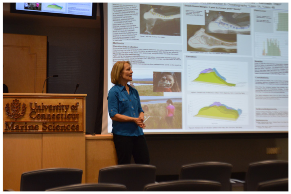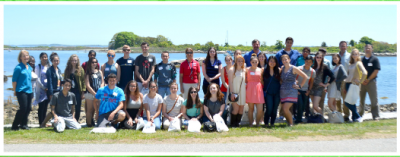by Anna Tworzyanski, Ledyard High School NOSB team member
At 8:30 AM, I and two of my fellow classmates pulled up to the UConn Avery Point Marine Sciences building overlooking a choppy Long Island Sound. When we entered, we were greeted with posters from other participating high schools covered with an array of research projects: everything from the relationship between temperature and jellyfish breeding to the use of a floating barge for passive desalination. Since the UConn ECE program assists in bridging the gap between learning basic skills and concepts in high school and solving real-life problems in higher education and beyond, it came as no
surprise that that was also the focus of this conference.
My school, Ledyard High School, was the first to present on our research of the changing shape and topography of Bushy Point Beach with respect to Superstorm Sandy in 2012. Spending a day on the shore and relating our findings to an event that all of us had experienced was already a fun class
project, but the opportunity to share our research with other high schools taking a UConn marine sciences course and those much farther ahead in their education made the experience even more fulfilling
In the demonstrations that followed, each presenter displayed a lot of enthusiasm in sharing their work with us and made the material fairly easy to understand even though it required much more specific knowledge than what we’ve been exposed to in high school.One graduate student even allowed
us into his nearby lab to see his work environment. During the next presentation, a UConn undergraduate student informed us of his experiences in the Sea Education Association Semester
and Research at Sea Program in which he spent several months on a boat in the South Pacific studying pteropod special distribution and shell condition with respect to pH. This practical knowledge ties in with the biological and chemical curricula we had in our class, especially in terms of the effect of global warming on the ocean. While it’s no question that I and my classmates understand the importance of oceanic research and development, we don’t all necessarily want to become oceanology majors. One of
the most meaningful parts of what this student shared with us was that many of those in the program with him were pursuing other studies. It was intriguing to me that I could maintain some attachment to the ocean sciences field even while working towards a different degree. Continuing on that thread, was doctoral candidate, Steven Schmidt, who took the time to explain to us his unique path from earth and planetary sciences to meteorology to conducting research on stratification and hypoxia in Long Island Sound. It was inspiring and reassuring to hear that although our educational paths may not end up where we thought, we can still utilize elements of the different fields we are exposed to during our education.
A couple of hours before lunch, we had a break to look at the other posters and talk with the students who had created them. The level of detail in the research and conducting of these high school experiments was impressive. I talked to one student from Bridgeport Regional Vocational Aquaculture
Center who aspires to work with Doctors without Borders, an international medical humanitarian organization. She had read about the use of trehalose, a carbohydrate found in seaweed, to stabilize vaccines for transportation to developing countries. After learning about phycoerythrin in red algae in her marine science class, she decided to use trehalose to stabilize phycoerythrin in a solar cell and took that project all the way to the Intel Science Talent Search competition. Another student analyzed the feathers and feces of cormorants and other piscivorous birds for toxic heavy metals using a scanning electron microscope and a spectrophotometer. It was amazing to see students who are at the same point in their education as myself and my classmates, who are able to take on real-world problems like renewable energy and pollution.
The day culminated in the launching of a balloon to collect atmospheric data, making use of thermal updraft. We were first briefed on the physics of the balloon and the critical importance of atmospheric data in oceanology. Afterwards, a few students helped in inflating the balloon and releasing it into
the air. Watching the balloon quickly drift past the nearby buildings was the perfect ending to the day; it reminded us that our marine science knowledge will take us as far as we want to go.



